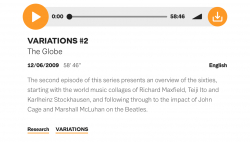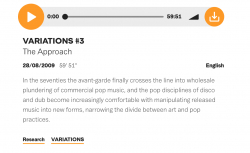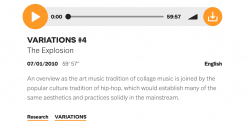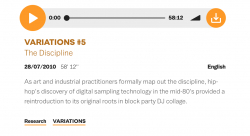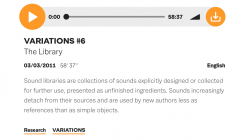VARIATIONS #1. Transition

Type
Audio/Visual
Authors
Leidecker ( Jon Leidecker )
Category
Podcast
[ Browse Items ]
Publication Year
2009
URL
[ private ]
Duration
58:08
Tags
Abstract
Variations is a seven part series history of appropriative collage in music, compositions made using recordings of older ones. It's a practice that in the '80s became known sampling — after the digital sampler — a breakthrough instrument which was designed to mimic traditional musical instruments by allowing the player to trigger recordings of them back on a keyboard. But it didn't take long for musicians to realize that the true strength of the sampler was the way in which it made it easy easy to collage and manipulate the best sounds from their favorite records into new pieces of music. This practice entered the popular mainstream by the 80s, long after observers had already identified collage as the defining new art form of the 20th century — and the roots of this music go back just as far. Over the course of this series, Leidecker looks at these roots, as appropriative collage developed across experimental and mainstream paths.
The first episode of this overview of appropriative collage in music covers the years 1908 through 1961.
The idea of a completely original piece of music is fairly recent. Music was passed on through sound, through generations, even for centuries after the invention of written music. Only in the 14th century did it become standard practice for a composer to sign his name to a piece of music and claim it entirely as his own, giving rise to the cult of the individual composer. But as recording supplanted sheet music in the 20th century, the presence of communal influence became unavoidably obvious once again as composers began to use recordings to make new recordings. We can now hear the presence of more than one voice. And there is a reason why people don't say they listen to a record – they say that they play a record. From the beginning, recordings have been instruments.
The first episode of this overview of appropriative collage in music covers the years 1909 through 1961, beginning with Charles Ives, who composed in a cut and paste style with sheet music in a way that anticipated what later composers would do with multi-track tapes and mixers. We skip through decades to arrive at "Twisting the Dials", the Happiness Boys' 1928 tribute to late night radio surfing, before moving to John Cage's proto-sampling pieces for radio and tape, "Credo in US" and the "Imaginary Landscapes". We witness the million-selling cut-in records of Buchanan and Goodman and the resulting lawsuits, Richard Maxfield's tape cut-ups of a sermonizing preacher, and conclude with James Tenney's dedicated dissection of a single recording of Elvis: "Collage No. 1", the first 'remix'.
The first episode of this overview of appropriative collage in music covers the years 1908 through 1961.
The idea of a completely original piece of music is fairly recent. Music was passed on through sound, through generations, even for centuries after the invention of written music. Only in the 14th century did it become standard practice for a composer to sign his name to a piece of music and claim it entirely as his own, giving rise to the cult of the individual composer. But as recording supplanted sheet music in the 20th century, the presence of communal influence became unavoidably obvious once again as composers began to use recordings to make new recordings. We can now hear the presence of more than one voice. And there is a reason why people don't say they listen to a record – they say that they play a record. From the beginning, recordings have been instruments.
The first episode of this overview of appropriative collage in music covers the years 1909 through 1961, beginning with Charles Ives, who composed in a cut and paste style with sheet music in a way that anticipated what later composers would do with multi-track tapes and mixers. We skip through decades to arrive at "Twisting the Dials", the Happiness Boys' 1928 tribute to late night radio surfing, before moving to John Cage's proto-sampling pieces for radio and tape, "Credo in US" and the "Imaginary Landscapes". We witness the million-selling cut-in records of Buchanan and Goodman and the resulting lawsuits, Richard Maxfield's tape cut-ups of a sermonizing preacher, and conclude with James Tenney's dedicated dissection of a single recording of Elvis: "Collage No. 1", the first 'remix'.
Description
https://ubu.com/sound/leidecker.html
Number of Copies
1
| Library | Accession No | Call No | Copy No | Edition | Location | Availability |
|---|---|---|---|---|---|---|
| Main | 315 | 1 | Yes |
